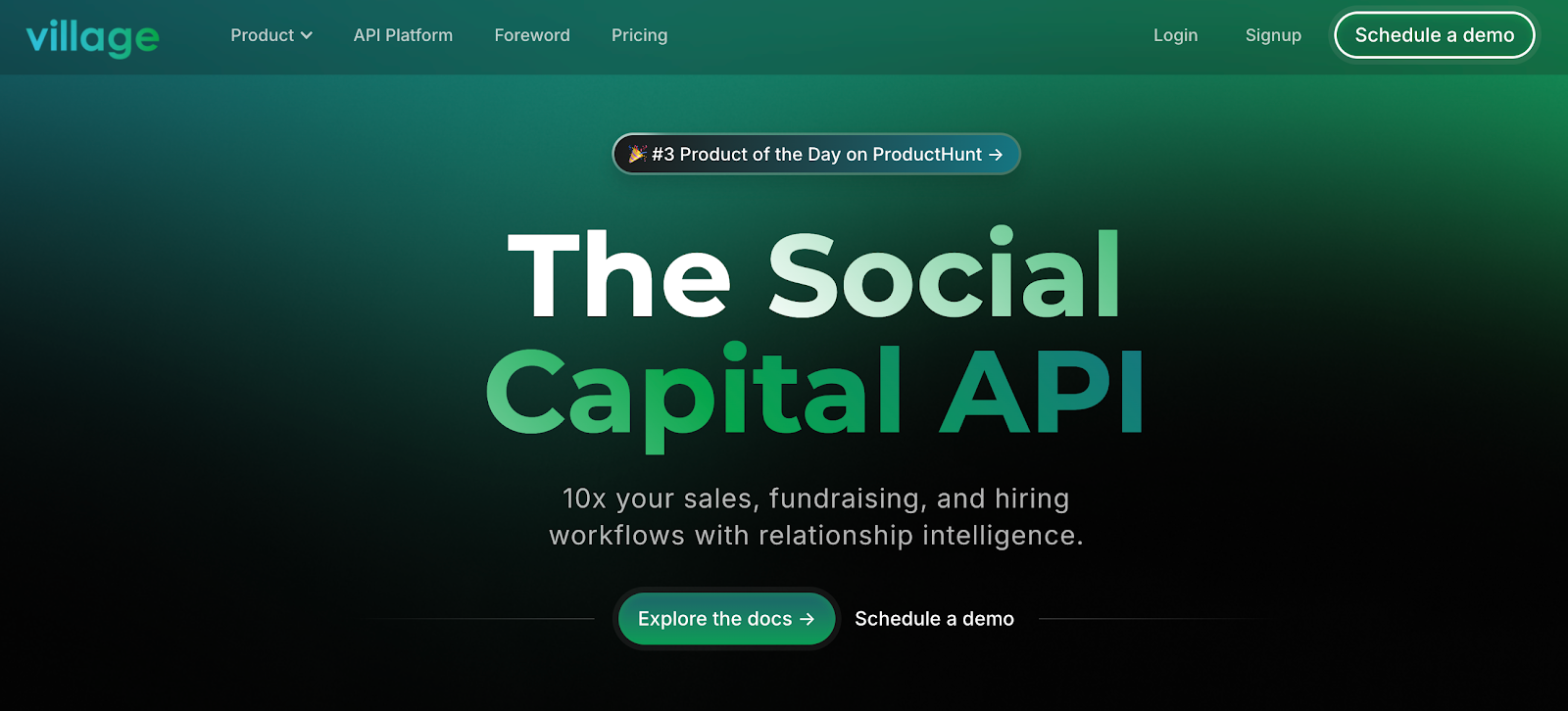Most business moves start with a connection. Maybe it’s someone you know. Perhaps it’s someone your colleague can introduce you to.
The challenge is spotting those connections when your network is scattered. Business relationship mapping helps you pull it all together. It shows who’s connected, how strong those ties are, and where it makes sense to reach out.
In this comprehensive guide to relationship mapping, you’ll learn how mapping works, how to build one, and how to use it when you're selling, hiring, or expanding an account.
What Does Business Relationship Mapping Mean?
You might already have hundreds of professional connections, but without a structure in place, they’re hard to use. A visual representation of your network helps you organize ideas around the contacts that support your sales strategy, recruiting, or account planning.
Business mapping helps you get a clear picture of the following:
- Warm paths to decision makers you’ve been struggling to reach
- Weak spots with existing clients that could use extra attention
- Missed chances sitting inside your existing accounts
If you’re trying to move faster in the sales cycle or keep business from slipping through the cracks, this process makes your network usable. That’s what makes relationship mapping important. It helps teams understand how people connect, where trust already exists, and where the gaps need attention.
Relationship Categories to Include in Your Map
Once you’ve added names to your map, you need to give those connections meaning. Not every relationship moves at the same pace or carries the same weight. Labeling each one helps your team read the map, make decisions faster, and avoid wasted outreach.
Use these common categories to describe how people interact.
Deference
This type shows a relationship based on authority or expertise. One person follows another’s lead because of experience or position. You’ll often find this between team leads and their direct reports.
In a sales setting, this helps you see who may follow direction from someone else rather than act independently.
Influence
This category reflects trust and informal authority. One person can shape another’s decisions through credibility, shared history, or past success.
Labeling these relationships helps sales leaders and account managers spot trusted contacts who can help move conversations forward. These connections often open doors to decision makers without going through formal channels.
Resistance or Conflict
Sometimes, relationships work against your goal. One person might push back on another’s ideas, block progress, or slow momentum. You may see this when roles are misaligned or when a previous deal left friction behind.
Identifying these patterns helps you avoid surprises and plan better outreach. In account planning or project management, this can make the difference between progress and delay.
Benefits of Relationship Mapping for Existing Accounts
When done right, relationship mapping helps you protect accounts, speed up outreach, and avoid missing chances with the people already in your orbit.
Identify Gaps and Catch Weak Spots Early
Maps highlight relationships that are missing, fading, or unbalanced. This gives you time to step in before clients pull back or go quiet. Teams often use maps during account planning to quickly identify at-risk connections and fix them before renewal talks begin.
Even small shifts matter. Increasing customer retention by just 5% can raise revenue anywhere from 25 to 95%. That kind of gain shows what’s possible when you fix weak ties instead of waiting for churn to happen.
Find Faster Ways to Reach Key People
Selling into large companies takes more than a contact list. You need context. Relationship maps help sales reps find warm intros, spot shared history, and focus outreach where trust already exists.
This saves time and cuts down on missed connections, especially with complex or high-value target accounts.
Make Smarter Decisions Based on Data Visualization
A map shows how people relate. You can see influence, blockers, and communication gaps at a glance. This helps your team plan outreach, shift strategies, or loop in the right contacts during the sales process.
Keep Everyone Aligned Across the Account
Inside larger companies, it’s easy to lose track of professional connections across teams. Mapping helps revenue teams and account managers stay on the same page and work from shared context.
That means fewer missed updates, better timing, and a stronger experience for existing clients.
Get More From the Tools You Already Use
When you connect mapping with your customer relationship management (CRM) platform, you gain more visibility without adding extra tools. Your team can track progress, update contact details, and keep outreach consistent using a single source of truth.
How to Build Your First Relationship Map

You don’t need a huge team or complicated software to start mapping relationships. What you need is a clear goal, the right tools, and a simple way to act on the information you already have.
Follow these steps to build a map that works.
1. Define Your Goal
Start by deciding what you want this map to help with. Are you trying to support a sales strategy, protect a renewal, or improve handoffs between teams?
A clear goal keeps you focused on the key relationships tied to that outcome. Without it, the map quickly becomes too broad to use.
2. Gather Information From Your Team and Tools
Collect details from emails, CRM records, meetings, or internal notes. Talk to people who manage the account or interact regularly with the client. These data sources give you more than job titles. They help you assess relationship strength based on real-world interactions.
Use this step to connect what lives in people’s heads to what your team can act on.
3. List the People Involved
Focus on the contacts that matter most. Include the buyer, anyone influencing the purchase, blockers, and those who will be involved post-sale. If your work touches several business units, make sure each one is represented.
The goal is to identify key stakeholders, not collect every name tied to the account.
4. Define How They Relate to One Another
Look at the flow of trust, influence, and resistance. Use relationship types like influence, deference, or conflict to describe how people interact. This adds meaning to the map and helps your team act with clarity.
Your relationship map is not just a chart. It’s a live tool for reading real dynamics.
5. Build the Map Visually
Use a template or relationship mapping software to draw the connections. Color, proximity, and line weight can help show strength and type. Many teams use tools with built-in tracking for complex relationships across departments.
Focus on making the map readable. Focus on fewer than 20 people so the map stays readable and actionable. Start with the contacts most relevant to your goal, or people involved in decisions, communication, or delivery.
6. Use the Map to Guide Outreach and Planning
Once your map is in place, use it. Sales teams can plan who to contact first. Account managers can repair weak ties with existing accounts. Sales leaders can track progress across teams and guide strategy using live data.
Treat the map as something you update over time. Schedule a review every few months to keep it accurate and useful. That’s part of what makes effective relationship mapping so valuable for sales and customer teams.
Use Cases for Business Relationship Mapping
Relationship mapping fits into more than one part of the business. Whether you’re selling, managing accounts, or leading a team through change, a well-built map helps you drive growth with clarity.
These examples show how different teams use mapping to improve results.
Sales
Sales teams use relationship maps to shorten cycles and increase success rates. With complex deals, there are often six or more decision makers involved. Without a clear map, it’s easy to miss someone important or aim outreach in the wrong direction.
Maps help reps find warm intros, focus on key stakeholders, and understand internal influence. They also support sales leaders who need a repeatable process for target accounts and expansion planning.
Customer Success
For customer success teams, maps help track who's involved in delivery, renewals, and account growth. These teams often inherit accounts without much context. A map gives them a clear view of contacts, relationships, and existing clients who may need more attention.
It’s also a useful tool during renewal conversations. When teams can spot weak or fading relationships early, they can act before retention becomes a problem.
Business Consulting
Consultants use maps to understand the internal structure of their client organizations. During planning or change efforts, a stakeholder relationship map helps identify resistance, influence, and informal power dynamics that might not show up in organizational charts.
This helps consultants guide teams through transitions, shift relationships where needed, and improve how departments align.
Project Management
Project leads use maps to track communication across complex teams. A map can reveal where handoffs might fail or where clients expect more involvement. This keeps work aligned across internal and client-facing roles.
Mapping relationships in project management supports delivery planning and helps prevent avoidable delays.
Executive and Strategic Planning
Leadership teams use mapping to support resource planning, cross-functional strategy, and building meaningful relationships across the company. This is especially important during growth, restructuring, or post-acquisition phases.
When leaders see a holistic view of internal and external contacts, they can make clearer decisions and reduce misalignment between teams.
Partnerships and Alliances
Maps also help when you're working with other companies. In partnerships, it’s easy to assume relationships exist when they don’t. A map helps you confirm where access exists, where support is missing, and how to move forward with shared goals.
This applies both during partnership setup and while managing the relationship over time.
Recruiting and Talent Planning
Recruiters often rely on internal referrals, but those networks are rarely mapped out. A relationship map highlights informal professional connections that may lead to stronger candidates and faster hires.
It’s also helpful when hiring across business units or when multiple teams are involved in the selection process.
Use Relationship Mapping to Reach Key Accounts

If you want to reach key decision makers, protect key accounts, or turn referrals into real results, you need more than a list of names. You need the right tools to create relationship maps that show who matters and how to reach them.
That’s exactly what Village delivers.
Village is one of the most effective relationship mapping tools available. It helps you sync contacts, uncover trusted connections, and act on real relationship intelligence.
Whether you're focused on stakeholder management, finding new clients, or keeping existing customers engaged, Village gives you a clear starting point.
You can use it to:
- Discover warm paths with context, not cold lists
- Uncover valuable insights based on real collaboration, shared history, and trust
- See how your network connects across companies, teams, and industries
- Integrate with your CRM for better visibility and improved CRM adoption
It’s a practical solution for building relationships, growing accounts, and getting a clear understanding of where to go next.
Use Village for free to map your network and test warm intros or book a demo to see how it fits into your sales, recruiting, or product strategy.
FAQs About Business Relationship Mapping Guide
How do you map business relationships?
Start by defining your goal. Then collect data from sources like your CRM, internal notes, and team conversations. Focus on identifying key players, mapping out how they relate, and using a tool that helps you visually represent those relationships. Keep your first map focused so you can use it right away.
What are the three steps to relationship mapping?
Most teams follow a simple framework:
- Collect data from internal systems, team knowledge, and past interactions.
- Identify important stakeholders and define their roles, influence, and connections.
- Create the map using software that makes relationships clear and easy to act on.
This process gives you structure and helps with day-to-day decisions, especially in sales, recruiting, and account management.
What does a relationship map look like?
A relationship map is a visual chart made up of people (nodes) and the connections between them (lines). It might show a formal structure, like in organizational charts, or informal connections based on trust, influence, and collaboration. Some maps focus on one side of the relationship, while others show both internal and external contacts.
How to map out relationships?
Begin with the most relevant contacts. Focus on those who influence outcomes, block progress, or connect your team to potential clients or internal allies. Use mapping software to organize these connections and update the map regularly as relationships shift. A focused map helps you spot gaps, plan outreach, and build on the meaningful relationships you already have.









